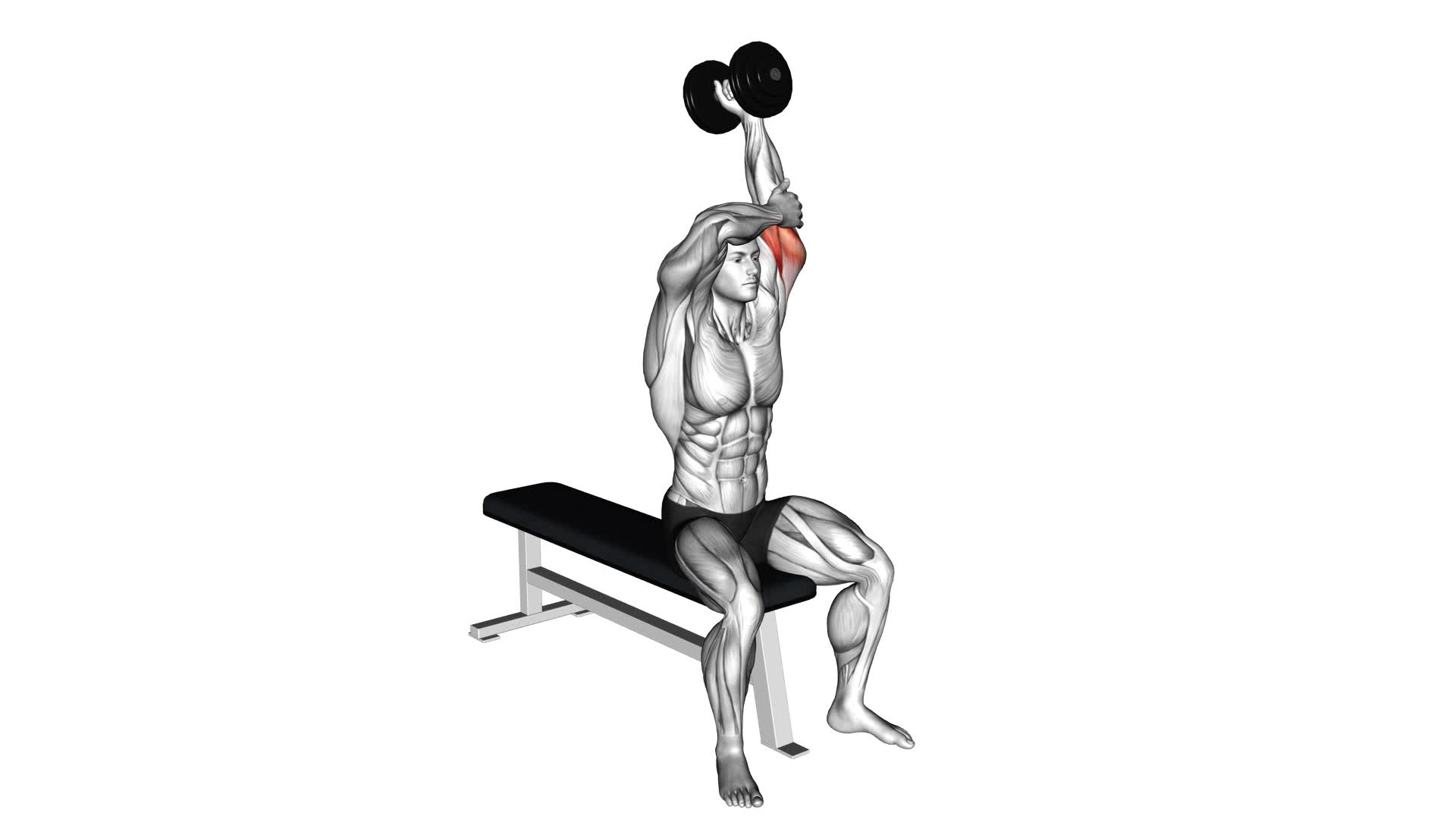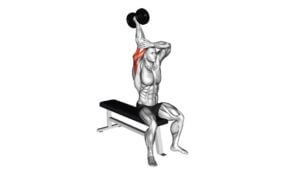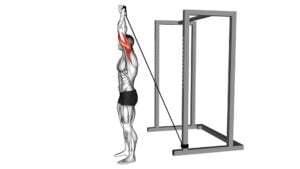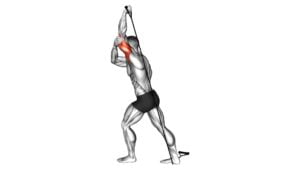Dumbbell Seated Single Arm Overhead Triceps Extension (left) – Video Exercise Guide & Tips

Are you looking to strengthen and tone your triceps? Look no further than the dumbbell seated single arm overhead triceps extension (left). This exercise targets your triceps, helping you achieve those sculpted arms you've always wanted.
Watch This Exercise Video
In this video exercise guide, we'll show you the proper form and setup, guide you step-by-step through the exercise, and provide tips to maximize its effectiveness.
Get ready to feel the burn and see results with this powerful triceps exercise.
Key Takeaways
- Targets the triceps muscles and helps strengthen and tone the back of the upper arms.
- Provides stability and support to the body.
- Can be performed with dumbbells for versatility.
- Proper form and technique are important to avoid common mistakes and maximize effectiveness.
Proper Form and Setup
To perform the Dumbbell Seated Single Arm Overhead Triceps Extension (left) exercise correctly, position yourself in a seated position with a dumbbell in your left hand. This exercise is highly beneficial for your triceps as it targets and strengthens the muscles in the back of your upper arm.
Seated triceps exercises, like this one, provide stability and support to your body, allowing you to focus solely on isolating and working your triceps.
When it comes to equipment options for triceps workouts, dumbbells are a popular choice. They're versatile, easily adjustable, and allow for a wide range of motion.
Start by sitting on a bench or chair with your feet flat on the floor. Hold the dumbbell in your left hand, with your palm facing upward. Extend your left arm overhead, keeping your elbow close to your ear. Slowly lower the dumbbell behind your head, bending your elbow until your forearm is parallel to the floor. Pause for a moment, then return to the starting position by extending your arm back up. Repeat for the desired number of repetitions.
Remember to maintain proper form throughout the exercise, keeping your back straight and your core engaged. Focus on the contraction of your triceps as you perform each repetition.
Keep in mind that it's important to start with a weight that's challenging but manageable, and always consult with a healthcare professional before starting any new exercise program.
Muscles Targeted During the Exercise
Target your triceps effectively with the Dumbbell Seated Single Arm Overhead Triceps Extension (left) exercise. This exercise primarily targets the triceps muscles, which are located at the back of your upper arm.
Here are the key muscles that are activated during this exercise:
- Triceps Brachii: The main muscle targeted in this exercise, it's responsible for extending the elbow joint.
- Deltoid: The anterior and lateral heads of the deltoid also play a supporting role in stabilizing the shoulder joint during the movement.
- Rhomboids: These muscles located between the shoulder blades are activated to stabilize the scapula and maintain proper posture.
- Core Muscles: To maintain stability and balance during the exercise, your core muscles, including the abdominals and lower back, are engaged.
To modify the exercise for advanced users and increase the challenge, you can use heavier dumbbells or perform the exercise in a standing position. Standing requires greater stability and engages more muscles for balance, making it a more challenging variation of the exercise.
Remember to use proper form and start with a weight that allows you to maintain control throughout the movement. Gradually increase the weight as you become more comfortable and confident in your ability to perform the exercise correctly.
Step-By-Step Guide for Performing the Exercise
Sit on a bench with a dumbbell in your left hand for the Dumbbell Seated Single Arm Overhead Triceps Extension (left) exercise. Start by holding the dumbbell with a neutral grip, your palm facing inward. Place your feet firmly on the ground, shoulder-width apart, and make sure your back is straight. This will be your starting position.
Inhale as you slowly raise the dumbbell overhead, keeping your upper arm close to your head. Extend your arm fully while exhaling, making sure to engage your triceps throughout the movement. Hold this position for a second to maximize the contraction.
Next, lower the dumbbell back to the starting position in a controlled manner while inhaling. Repeat the movement for the recommended number of repetitions, then switch to your right hand to work the other arm.
Proper breathing techniques are essential during this exercise. Remember to inhale as you raise the dumbbell overhead and exhale as you extend your arm. This helps stabilize your core and provides additional support to your muscles.
The Dumbbell Seated Single Arm Overhead Triceps Extension (left) exercise targets the triceps, helping to strengthen and tone the back of your upper arms. It also engages the core muscles to maintain stability throughout the movement.
Common Mistakes to Avoid
To perform the dumbbell seated single arm overhead triceps extension correctly, make sure to avoid some common mistakes.
First, ensure that your elbow is positioned correctly throughout the exercise, as incorrect positioning can reduce the effectiveness of the movement.
Secondly, be mindful of achieving a sufficient range of motion, as stopping short can limit the benefits of the exercise.
Lastly, maintain stability throughout the movement to prevent any unnecessary strain or injury.
Incorrect Elbow Positioning
Avoid bending your elbow too much during the dumbbell seated single arm overhead triceps extension exercise. Improper technique can lead to injuries and hinder your progress. Here are some common mistakes to avoid:
- Overextending the elbow: Avoid locking out your elbow at the top of the movement, as this puts unnecessary strain on the joint.
- Not keeping the elbow stable: Make sure to keep your elbow in a fixed position throughout the exercise to isolate your triceps effectively.
- Swinging the arm: Maintain control and avoid using momentum to lift the weight. This ensures that your triceps are properly engaged.
- Lack of control during the descent: Lower the dumbbell slowly and under control to maximize the effectiveness of the exercise.
By avoiding these mistakes, you can perform the dumbbell seated single arm overhead triceps extension correctly and reduce the risk of injury.
Now, let's discuss the next common mistake: insufficient range of motion.
Insufficient Range of Motion
To maximize the effectiveness of the dumbbell seated single arm overhead triceps extension, ensure adequate range of motion during the exercise. Insufficient range of motion can limit the engagement of your triceps muscles and hinder your progress.
To avoid this mistake, focus on improving flexibility in your shoulders and elbows. Prioritize stretching exercises that target these areas, such as shoulder circles and triceps stretches. By regularly performing these exercises, you can gradually increase your range of motion and enhance the effectiveness of the triceps extension.
Additionally, if you find it challenging to achieve the full range of motion with the dumbbell seated single arm overhead triceps extension, consider alternative exercises such as cable triceps pushdowns or triceps dips to effectively target and strengthen your triceps.
Lack of Stability
Ensure that you maintain stability throughout the dumbbell seated single arm overhead triceps extension exercise to avoid common mistakes. Increasing stability is crucial for performing this exercise correctly and maximizing its benefits.
Here are some tips to help you maintain stability:
- Engage your core: Keep your abs tight and your back straight throughout the movement to provide a stable base.
- Maintain proper form: Keep your shoulder blades pulled back and down, and avoid excessive movement or swinging.
- Control the weight: Use a weight that allows you to maintain control and stability throughout the exercise.
- Focus on your balance: Pay attention to your body position and distribute your weight evenly to avoid leaning or tilting.
Variations and Modifications for Different Fitness Levels
How can you modify the dumbbell seated single arm overhead triceps extension (left) exercise to suit your fitness level? Whether you're an advanced athlete looking for variations or an individual with limited mobility in need of modifications, there are options available to accommodate your specific needs.
For advanced athletes, you can increase the difficulty of the exercise by using a heavier dumbbell or incorporating additional resistance, such as resistance bands or weighted cuffs. This will challenge your triceps muscles even more and help you continue to progress in your strength training journey.
On the other hand, if you have limited mobility, there are modifications that can be made to make the exercise more accessible. One option is to perform the exercise while seated on a stability ball instead of a bench. This will provide additional support and help reduce strain on your lower back. Additionally, you can use a lighter dumbbell or even just your body weight to perform a seated triceps extension with both arms instead of just one.
Tips for Maximizing the Effectiveness of the Exercise
To maximize the effectiveness of the dumbbell seated single arm overhead triceps extension, it's important to focus on proper form techniques.
Keep your core engaged and your back straight throughout the exercise.
Additionally, make sure to activate your triceps by fully extending your arm and squeezing the muscle at the top of the movement.
Beginners can start with lighter weights or perform the exercise with both arms simultaneously to build strength before progressing to single-arm variations.
Proper Form Techniques
Maximize the effectiveness of the exercise by focusing on proper form techniques. Follow these tips to ensure you're performing the Dumbbell Seated Single Arm Overhead Triceps Extension correctly:
- Maintain a stable seated position throughout the exercise to engage your core and prevent unnecessary strain on your back.
- Keep your upper arm parallel to the ground and close to your head, ensuring that it remains stationary throughout the movement.
- Lower the dumbbell slowly and under control, feeling a stretch in your triceps. Avoid rushing through the exercise.
- Exhale as you extend your arm upwards, fully contracting your triceps at the top of the movement.
By implementing these form techniques, you won't only improve your muscle activation cues but also reduce the risk of injury.
Now, let's move on to discussing muscle activation cues to further optimize your triceps workout.
Muscle Activation Cues
To maximize the effectiveness of the exercise, focus on engaging your triceps by maintaining proper form and following these muscle activation cues.
- First, make sure to keep your elbow stationary throughout the movement. This will ensure that the tension is placed solely on your triceps.
- Next, fully extend your arm overhead, feeling a stretch in your triceps.
- As you lower the dumbbell, exhale and contract your triceps forcefully.
- Remember to keep your core engaged and your back straight for stability.
If you're a beginner, you can modify this exercise by using a lighter weight or starting with both arms instead of one. Gradually increase the weight as you become more comfortable and confident in your form.
Modifications for Beginners
To modify the dumbbell seated single arm overhead triceps extension (left) exercise for beginners and maximize its effectiveness, start by using a lighter weight or both arms instead of one. This will help you focus on proper form and build strength gradually. Here are some beginner modifications and progressions to consider:
- Start with a lighter dumbbell or even a water bottle to get used to the movement.
- Perform the exercise with both arms simultaneously to distribute the workload evenly.
- Use a resistance band instead of a dumbbell to reduce the intensity.
- Begin by performing the exercise seated on a bench or chair with back support for stability.
Frequently Asked Questions
How Many Sets and Reps Should I Do for This Exercise?
For this exercise, it's important to determine the number of sets and reps that work best for you. Start with a weight that challenges your triceps but allows you to maintain proper form. Aim for 3-4 sets of 8-12 reps, resting 60-90 seconds between sets.
Remember to keep your core engaged and your back straight throughout the movement. If you're looking to mix things up, you can also try variations like using a resistance band or performing the exercise standing up.
Can I Use a Kettlebell Instead of a Dumbbell for This Exercise?
Yes, you can definitely use a kettlebell instead of a dumbbell for this exercise. The kettlebell alternative provides a similar challenge to your triceps muscles.
The seated position in this exercise is beneficial as it helps stabilize your body, allowing you to focus on targeting your triceps effectively.
Remember to maintain proper form and control throughout the movement to maximize the benefits of this exercise.
Is This Exercise Suitable for Beginners?
Yes, this exercise is suitable for beginners.
To perform the dumbbell seated single arm overhead triceps extension with proper form and technique, follow these steps:
- Sit on a bench with your back straight.
- Hold a dumbbell in your left hand.
- Extend your arm overhead, keeping your elbow close to your head.
- Slowly lower the dumbbell behind your head, feeling a stretch in your triceps.
For beginners, there are progression options available:
- Start with a lighter weight.
- Gradually increase the resistance as you get stronger.
What Other Exercises Can I Do to Target the Triceps?
To target your triceps, there are plenty of alternatives to dumbbell exercises. Push-ups, tricep dips, and close-grip bench press are all effective options.
Remember to maintain proper form and technique to prevent triceps injuries. Keep your elbows close to your body and avoid locking your elbows during the exercises.
Focus on contracting your triceps muscles throughout the movements.
With consistency and proper execution, you'll see great results in your triceps strength and definition.
Can I Perform This Exercise Standing Instead of Seated?
If you're wondering about the standing vs seated variations of the exercise, the dumbbell seated single arm overhead triceps extension can also be performed while standing.
However, the seated position provides some benefits, like stability and isolation of the triceps. It allows you to focus on the muscle group without compensating with other body parts.
Conclusion
In conclusion, the dumbbell seated single arm overhead triceps extension is a highly effective exercise for targeting and strengthening the triceps muscles. By following the proper form and setup, performing the exercise step-by-step, and avoiding common mistakes, you can maximize the effectiveness of this exercise.
Additionally, variations and modifications are available to suit different fitness levels. By incorporating this exercise into your routine and following the provided tips, you can achieve optimal results for your triceps muscles.

Author
Years ago, the spark of my life’s passion ignited in my mind the moment I stepped into the local gym for the first time. The inaugural bead of perspiration, the initial endeavor, the very first surge of endorphins, and a sense of pride that washed over me post-workout marked the beginning of my deep-seated interest in strength sports, fitness, and sports nutrition. This very curiosity blossomed rapidly into a profound fascination, propelling me to earn a Master’s degree in Physical Education from the Academy of Physical Education in Krakow, followed by a Sports Manager diploma from the Jagiellonian University. My journey of growth led me to gain more specialized qualifications, such as being a certified personal trainer with a focus on sports dietetics, a lifeguard, and an instructor for wellness and corrective gymnastics. Theoretical knowledge paired seamlessly with practical experience, reinforcing my belief that the transformation of individuals under my guidance was also a reflection of my personal growth. This belief holds true even today. Each day, I strive to push the boundaries and explore new realms. These realms gently elevate me to greater heights. The unique combination of passion for my field and the continuous quest for growth fuels my drive to break new ground.







